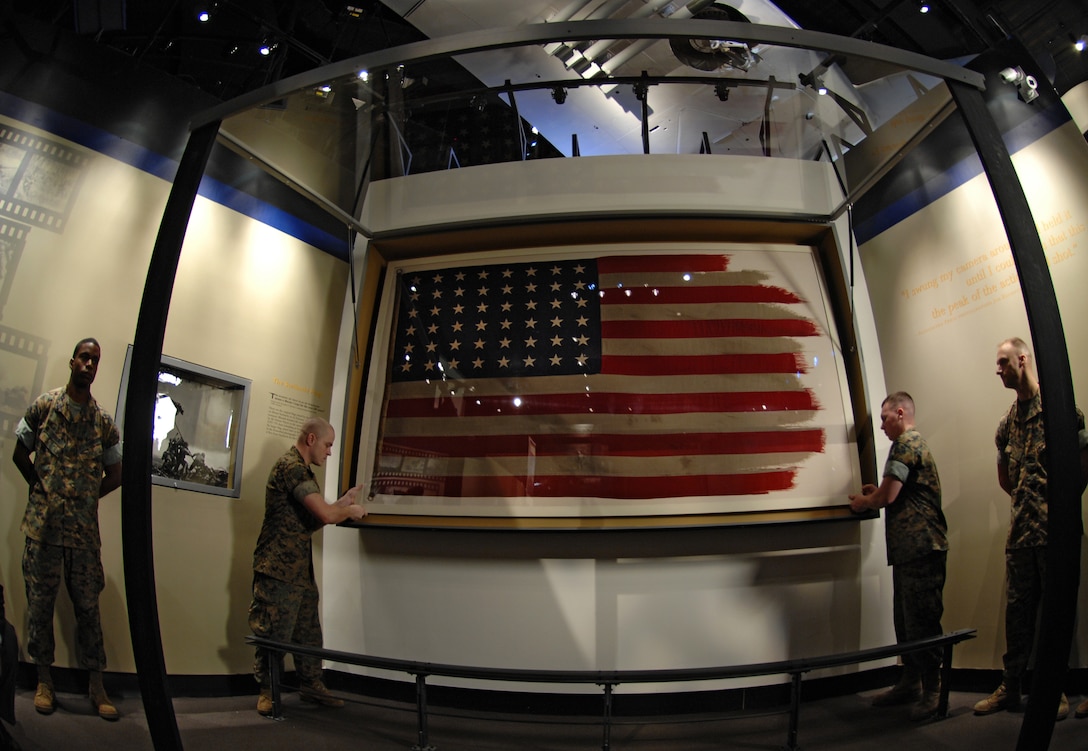The battle began on February 19. Four days later, the Marines had fought their way to the top of Mount Suribachi. A 54-by-28-inch flag -- 4-foot-6 by 2-foot-8 -- was attached to an iron water pipe they'd found, and was planted at 10:30 AM local time.
But Colonel Chandler Johnson decided that the flag wasn't big enough to be seen by all the troops on the island -- on both sides. He wanted a bigger one. He wanted the Japanese soldiers to see it, as a blow to their morale. One was found from a nearby ship: 96-by-56-inch, or 8-foot-even by 4-foot-8, taller than the first flag was long.
Six men raised it. From left to right in the photo, they were:
* Private 1st Class Ira Hayes, 22, a member of the Gila River tribe, from Sacaton, Arizona.
* Private 1st Class Harold Schultz, 20, from Detroit.
* Sergeant Michael Strank, 24, born in what is now Jarabina, Slovakia, and raised in Franklin, in Western Pennsylvania.
* Private 1st Class Franklin Sousley, 19, from Hill Top, Kentucky.
* Private 1st Class Harold Keller, 23, from Brooklyn, Iowa. And...
* Corporal Harlon Block, 20, from Weslaco, Texas.
Corporal René Gagnon was one of the men who carried the flag up to Mount Suribachi. He was long believed to be one of the men in the photograph. In 2019, an investigation revealed that the raiser previously thought to be Gagnon was actually Keller. And Navy Pharmacist's Mate Second Class John Bradley was another misidentified as one of the flag-raisers. In 2016, the figure thought to be Bradley was determined to be Sousley.
In addition to the photo by Rosenthal, a 33-year-old native of Washington, D.C., working for the Associated Press, a color film of the raising was made by Marine Sergeant Bill Genaust, 38, from Minneapolis.
But the battle was not over. Indeed, of the 6 men who raised the flag, 3 did not make it off the island alive: Strank was hit, probably by "friendly fire," an American artillery shell, on March 1; Block was killed by an enemy mortar shell later that same day; Genaust was killed 2 days later, trying to flush some enemy soldiers out of a cave; and Sousley was shot in the back by a Japanese sniper on March 21.
When the Japanese finally surrendered on March 26, only 216 of the 21,000 men they started with had lived long enough to be taken prisoner. Of the 110,000 Americans to take part in the battle, 6,762 died -- more in 1 month on this one small island than died in the entire 8 years of the Iraq War.
The next step was Okinawa, which was even bloodier. That was supposed to be the final stop before the invasion of the home islands, which might have been the deadliest battle in human history. It was prevented by the atomic bombs on Hiroshima and Nagasaki, and Japan's subsequent surrender.
Rosenthal's photo of the 2nd flag raising was published 2 days later, and became one of the iconic images in the history of warfare. It was used as the basis for the Marine Corps National Memorial, erected at Arlington National Cemetery in 1954.
In 1949, John Wayne made the film Sands of Iwo Jima, indelibly linking him with the U.S. military effort in World War II, and with the Marines in particular, even though he hadn't served in the war: He was classified 3-A, meaning he had a deferment as his family's sole means of support.
In the Vietnam War era, Wayne despised draft dodgers, but while he didn't serve himself, it should be noted that he did not dodge: He simply wasn't drafted, with what the Army thought was a good reason. Hayes, Gagnon and Bradley, then believed to be the 3 flag-raisers who survived the battle, were among the veterans who were cast as witnesses to the film's version of the flag-raising.
Hayes suffered from what was then called "shell shock" or "battle fatigue," what's now known as "post-traumatic stress disorder." He dealt with it by drinking, and a night of excess killed him in 1955, only 32 years old. In 1965, as part of a concept album of songs about Native Americans, Johnny Cash sang "The Ballad of Ira Hayes."
Keller became a fireman in his Iowa hometown, and died of a heart attack in 1979.
Gagnon, who knew he wasn't one of the six flag-raisers, and never claimed he was one, became a travel agent in his native New Hampshire, and also died of a heart attack in 1979. Bradley, who admitted he had little to do with the flag-raising, also suffered from PTSD, became a mortician, and lived until 1994. Schultz moved to Los Angeles and became a postal worker. He was the last survivor of the six, falling victim to a heart attack on May 16, 1995, having lived just long enough to see the 50th Anniversaries of the flag-raising, and of V-E Day, though not of V-J Day.
Rosenthal outlived them all, dying in 2006, at the age of 94.
The U.S. kept control of Iwo Jima until 1968, at which point it returned control of the island to Japan. The 48-star, 13-stripe flag from the photo has been on display in the National Museum of the U.S. Marine Corps in Quantico, Virginia since 2006.












No comments:
Post a Comment